
The Shang dynasty, also known as the Yin dynasty, was a Chinese royal dynasty that ruled in the Yellow River valley during the second millennium BC, traditionally succeeding the Xia dynasty and followed by the Western Zhou dynasty. The classic account of the Shang comes from texts such as the Book of Documents, Bamboo Annals and Records of the Grand Historian. Modern scholarship dates the dynasty between the 16th and 11th centuries BC, with more agreement surrounding the end date than beginning date.

The Xia dynasty is the first dynasty in traditional Chinese historiography. According to tradition, it was established by the legendary figure Yu the Great, after Shun, the last of the Five Emperors, gave the throne to him. In traditional historiography, the Xia was succeeded by the Shang dynasty.
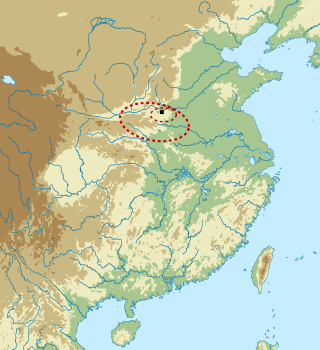
The Erlitou culture was an early Bronze Age society and archaeological culture. It existed in the Yellow River valley from approximately 1900 to 1500 BC. A 2007 study using radiocarbon dating proposed a narrower date range of 1750–1530 BC. The culture is named after Erlitou, an archaeological site in Yanshi, Henan. It was widely spread throughout Henan and Shanxi and later appeared in Shaanxi and Hubei. Most archaeologists consider Erlitou the first state-level society in China. Chinese archaeologists generally identify the Erlitou culture as the site of the Xia dynasty, but there is no firm evidence, such as writing, to substantiate such a linkage, as the earliest evidence of Chinese writing dates to the Late Shang period.

The Erligang culture is a Bronze Age urban civilization and archaeological culture in China that existed from approximately 1600 to 1400 BC. The primary site, Zhengzhou Shang City, was discovered at Erligang, within the modern city of Zhengzhou, Henan, in 1951.
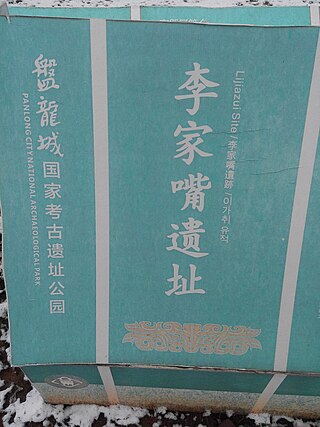
Panlongcheng or Panlong City is an archaeological site associated with the Erligang culture during the Shang dynasty period. The site is located just north of the Yangtze river, on the bank of the Panlong lake, and is surrounded by the Fushui river in Huangpi, Wuhan, Hubei, China. Panlongcheng is the largest excavated Erligang site, showing the southernmost reach of the Erligang culture at its peak. It was discovered in 1954, and excavated in 1974 and 1976.

The Dayangzhou Chengjia site is an archaeological site located on the Gan River in Dayangzhou Town, Xingan County, Jiangxi, China. The site was excavated in 1989, and it dates to around 1200 BCE. The rich offerings of bronze and jade objects made it the second richest burial site known after the Fu Hao's tomb.
The Wucheng culture (吳城文化) was a Bronze Age archaeological culture in Jiangxi, China. The initial site, spread out over 4 km2 (1.5 sq mi), was discovered at Wucheng Township, Jiangxi. Located on the Gan River, the site was first excavated in 1973. The Wucheng culture probably developed in response to cultural contacts with the expanding Erligang culture, melding Erligang influences with local traditions. The Wucheng culture was a distinct contemporary of Sanxingdui and Yinxu (Anyang).
The Xia–Shang–Zhou Chronology Project was a multi-disciplinary project commissioned by the People's Republic of China in 1996 to determine with accuracy the location and time frame of the Xia, Shang, and Zhou dynasties.
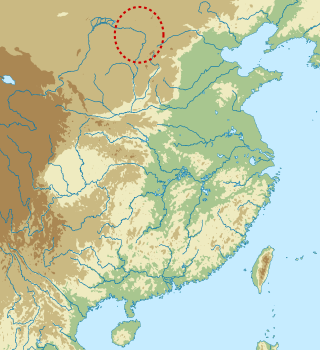
The Zhukaigou culture was a late Neolithic and early Bronze Age culture centered in the Ordos Plateau of Inner Mongolia, China. The type site at Zhukaigou was discovered in Ejin Horo Banner, Inner Mongolia, and excavated from 1977 to 1984. Zhukaigou culture is a reputed progenitor of the Ordos bronze culture and accordingly a first "Northern Zone" culture, extending to northern and central Inner Mongolia, northern Shaanxi, and northern Shanxi, with the Ordos region at its center. Transition to metalworking is dated to around the end of the third millennium BCE, at the same time was attained a higher level in the ceramic. Zhukaigou culture lasted to c. 1500 BCE.
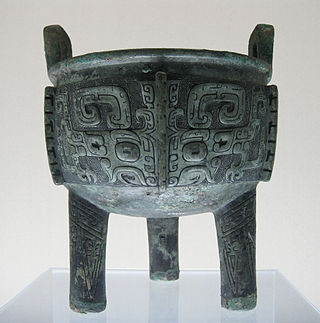
Shang archaeology is concerned with the archaeological evidence for the Chinese Shang dynasty. Choice of excavation sites and interpretation of finds have been heavily influenced by the textual historical record.

A gu is a type of ancient Chinese ritual bronze vessel from the Shang and Zhou dynasties. It was used to drink wine or to offer ritual libations.

The Zhengzhou Shang City is an archaeological site of the Bronze Age Erligang culture in Zhengzhou, Henan, China. Studies give it 4 chronological phases from 1630 to 1400 BC. The excavation of the site is of great importance in understanding the history of the dynasty. It is also one of the oldest archeological sites in China.
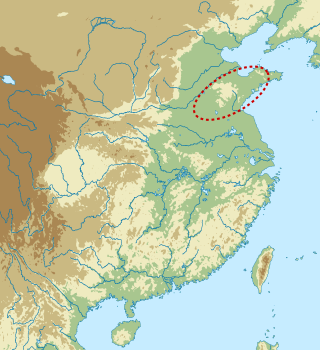
The Yueshi culture was an archaeological culture in the Shandong region of eastern China, dated from 1900 to 1500 BC. It spanned the period from the Late Neolithic to the early Bronze Age. In the Shandong area, it followed the Longshan culture period and was later replaced by the Erligang culture.
The Zhou–Chu War was a military conflict between the Zhou dynasty under King Zhao and the state of Chu from 961 to 957 BC. King Zhao personally led at least two major campaigns against Chu and other states and tribes of the middle Yangtze region, initially conquering the lands north of the Yangtze and the Han River valley. Eventually, however, the Zhou forces suffered a crushing defeat, with half of their armed forces as well as King Zhao killed, subsequently losing control of much conquered territory. The war ended the era of Western Zhou's early expansion and forced it into the defense against foreign aggressors. On the other side, Chu consolidated its de facto independence and would continue to grow into one of the most powerful states of China.
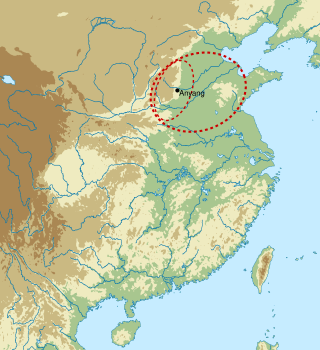
The Late Shang, also known as the Anyang period, is the earliest known literate civilization in China, spanning the reigns of the last nine kings of the Shang dynasty, beginning with Wu Ding in the second half of the 13th century BC and ending with the conquest of the Shang by the Zhou in the mid-11th century BC. The state is known from artifacts recovered from its capital at a site near Anyang now known as Yinxu and other sites across the North China Plain. One of the richest finds was the Tomb of Fu Hao at Yinxu, thought to belong to a consort of Wu Ding mentioned in Shang inscriptions.
Guandimiao is a Chinese archaeological site 18 km south of the Yellow River in Xingyang, Henan. It is the site of a small Shang dynasty village that was inhabited from roughly 1250 to 1100 BCE during the Late Shang period. Located 200 km from the Shang capital at Yinxu, the site was first studied as a part of excavations undertaken between 2006 and 2008 in preparation for the nearby South–North Water Transfer Project. Excavation and study at Guandimiao has significantly broadened scholars' understanding of rural Shang economies and rituals, as well as the layout of rural villages, which have received comparatively little attention in the field of Shang archaeology compared to urban centers like Yinxu and Huanbei.
Daxinzhuang is a Chinese archaeological site located near Daxinzhuang village in Licheng, Jinan, Shandong. Although early occupation in the vicinity has been dated to the Neolithic Longshan and Yueshi culture, the site became an urban center during the late Erligang, corresponding to a period of political and military expansion from the heartland of Henan into Shandong. Daxinzhuang became the type site of the Daxinzhuang type, a material culture type shared by other settlements along the Ji River.
The periodization of the Shang dynasty is the use of periodization to organize the history of the Shang dynasty in ancient China. The Shang dynasty was a Chinese royal dynasty that ruled in the Yellow River valley for over 500 years, traditionally succeeding the Xia dynasty and followed by the Zhou dynasty. According to the conventional narrative of later transmitted texts, the Shang clan, led by their great leader Tang, defeated Jie of the Xia dynasty and founded a new dynasty known as Shang. The Shang moved their capital several times during the existence of the dynasty, eventually settling in a place called Yin, later known in the transmitted texts as Yinxu, located on the outskirts of the modern city of Anyang. It was eventually conquered by the Predynastic Zhou led by King Wu following the Battle of Muye in ca. 1046 BC, which led to the establishment of the Western Zhou dynasty. Scholars divide the Shang dynasty into periods for convenience, usually relating to the location of the dynasty's capital.














